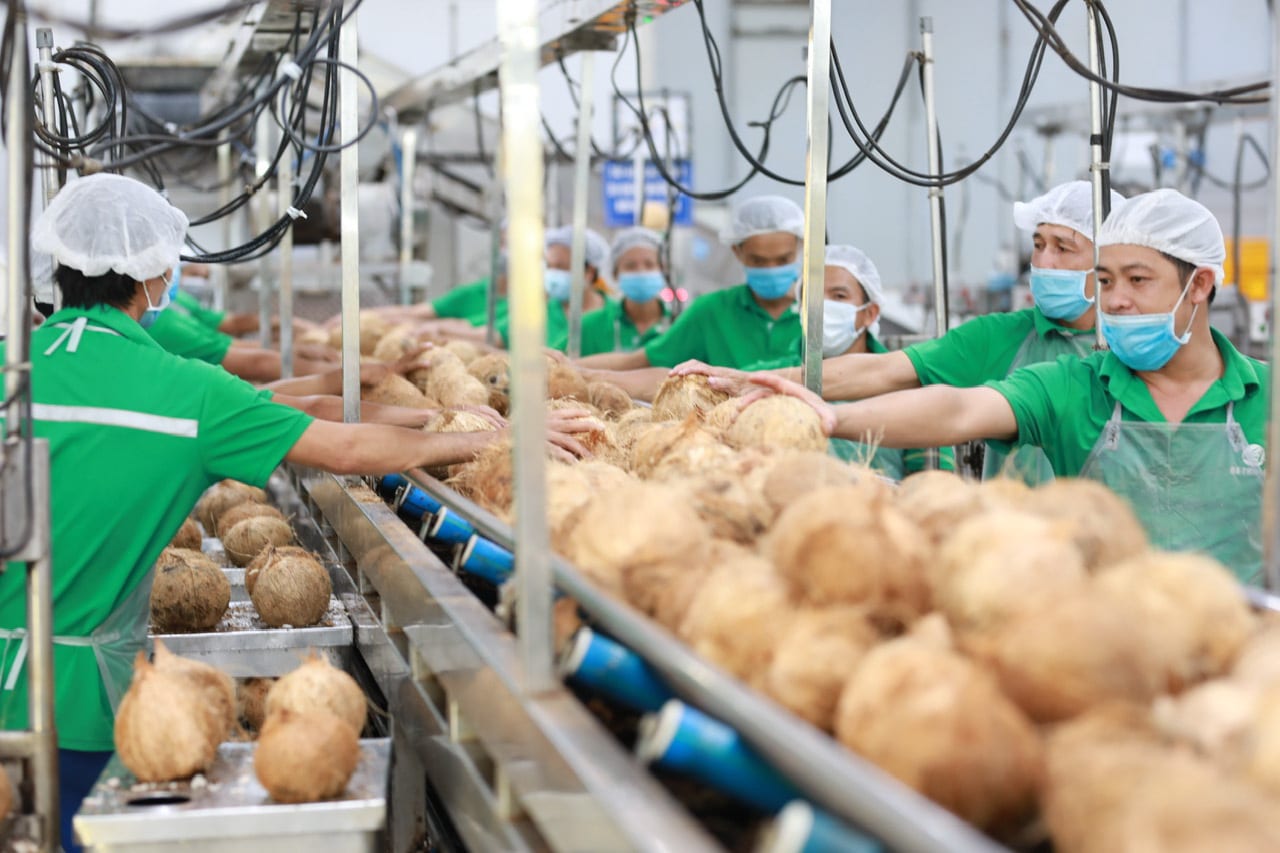
Never before has the term ‘green credit’ been so frequently mentioned by banks in Vietnam, who are now continuously collaborating with international organizations to capitalize on funding for green credit projects, all while being committed to reducing emission levels.
Banks assert that this trend is irresistible, foreseeing a stage where projects lacking environmental friendliness will be denied funding.
According to World Bank estimates, from now until 2040, Vietnam must invest an additional US$368 billion, roughly equivalent to 6.8 percent of its gross domestic product (GDP) annually, in the resilience and net-zero emissions roadmap.
Inevitable trend
On April 16, Standard Chartered Bank in Vietnam announced the signing of a memorandum of understanding with the United States Agency for International Development, marking a collaboration to mobilize private investment in advanced energy systems like rooftop solar power, upgrade the power grid system, and foster power trading initiatives.
In a separate initiative on April 12, United Overseas Bank Limited (UOB) Vietnam inked a green trade finance agreement with Ben Tre Import and Export Joint Stock Corporation (Betrimex), based in the Mekong Delta province of Ben Tre.
As per this agreement, UOB will extend short-term credit to assist Betrimex in importing or purchasing raw materials and domestic goods for producing products certified organic and fair trade.
These certifications ensure adherence to stringent requirements for social, environmental, and economic responsibility, encompassing safe working conditions, environmental conservation, sustainable livelihoods, and community development.
Lim Dyi Chang, UOB Vietnam’s commercial banking head, affirmed that this commitment reflects his bank’s dedication to supporting sustainable projects and businesses driving the transition toward a greener and more sustainable economy.
Prior to this, Orient Commercial Bank (OCB) also entered into an agreement with the International Finance Corporation (IFC), a member of the World Bank Group, to consult on the green banking transformation for sustainable development.
In the initial phase, IFC will allocate approximately $150 million to OCB for lending to businesses meeting green credit standards at preferential interest rates, focusing on industries such as renewable energy and environment-friendly high technology.
Nguyen Dinh Tung, general director of OCB, spotlighted the bank’s plan to offer specialized products tailored for green projects, such as green bonds, green credit, and green payment platforms.
“We will refine our products to ensure that OCB’s offerings contribute to minimizing environmental impact,” Tung said.
“Eventually, the bank will reject projects that are environmentally harmful and lack societal benefit.”
Earlier this year, Asia Commercial Joint Stock Bank (ACB) launched a VND2 trillion ($78.7 million) green and social credit package, prioritizing funding for businesses with plans in environmentally friendly categories, such as renewable energy, particularly solar power, energy efficiency, green building, and clean transportation.
These loans come with interest rates starting from six percent per annum for both short-term and long-term financing, along with exemptions and reductions of early repayment fees.
Scale remains modest
At the seminar ‘Greening the Banking Industry – Accelerating the Transition to a Low-Carbon Economy in Vietnam‘ held at the end of 2023, Deputy Governor of the State Bank of Vietnam (SBV) Pham Thanh Ha emphasized that green growth and sustainable development are inevitable trends pursued by every country, including Vietnam, which faces numerous environmental challenges and is severely impacted by climate change.
Ha highlighted the banking industry’s pivotal role as a significant financial conduit for the economy and underscored its obligation to greening investment capital flows in alignment with sustainable development goals.
As of December 31, 2023, 47 credit institutions held outstanding green credit debts totaling nearly VND621 trillion ($24.4 billion), marking a 24-percent increase compared to the previous year-end and accounting for approximately 4.5 percent of the total outstanding debt in the economy.
Pham Thi Thanh Tung, deputy director general of the SBV Department of Credit for Economic Sectors, noted that from 2017 to 2023, outstanding green credit loans within the banking system grew by over 22 percent annually.
Many credit institutions introduced tailored green credit packages and programs to align with the specific needs of businesses and facilitate green transformation.
Despite progress, Tung highlighted persistent challenges in promoting green credit. These include the absence of a green classification list, crucial for the SBV to evaluate the efficacy of credit policies toward national green growth objectives.
Additionally, it is essential for credit institutions to determine investment norms and scales and develop appropriate banking policies, products, and services.
Dr. Can Van Luc, a member of the National Financial-Monetary Policy Advisory Council, pointed out that despite over a decade of green finance deployment in Vietnam, its scale remains small, constituting only 4.4 percent of the total outstanding debt.
Luc highlighted the plethora of issues hindering the implementation of green credit, including the lack of legal frameworks and policies, encompassing taxation, fees, and preferential capital, related to green and sustainable finance initiatives.
Nguyen Hai Anh, deputy general director and chief financial officer of Shinec Joint Stock Company, which is the investor of Nam Cau Kien Industrial Park in Hai Phong City, northern Vietnam, shared that the firm is striving to establish the project as an eco-industrial park that meets green criteria.
This process requires substantial costs for greenery, land allocation, and engaging auditors and consultants.
“Notwithstanding these efforts, eco-industrial parks like Nam Cau Kien receive no incentives, and credit loans still carry standard interest, without any preferential treatment,” remarked Anh.
A driver for building a Green Vietnam
On April 20, the conference ‘Carbon Credit Market – A Driver for Building a Green Vietnam’ and the launch of the Green Vietnam project were held at the Van Thanh Tourism Area in Binh Thanh District, Ho Chi Minh City.
The event aimed to gather expert insights on establishing regulatory frameworks and facilitating the involvement of organizations and businesses in the carbon credit market.
During the conference, experts discussed the current state of the carbon credit market in Vietnam, government regulations and support mechanisms, forest preservation efforts and revenue generation from carbon credits, the potential of carbon credits from Vietnam’s forests, and future market projections.
The event was organized by Tuoi Tre (Youth) newspaper in partnership with the Ministry of Natural Resources and Environment, the Ho Chi Minh City Department of Natural Resources and Environment, the Vietnam Packaging Recycling Organization (PRO Vietnam), and other stakeholders.
Green classification system is crucial
Assoc Prof. Dr. Nguyen Dinh Tho, general director of the Institute of Strategy and Policy on Natural Resources and Environment, underlined the necessity for Vietnam to develop a green classification framework.
In October 2023, Europe introduced the Carbon Border Adjustment Mechanism, set to take effect from 2026, directly impacting various Vietnamese industries including steel, cement, and fertilizer.
Starting January 1, 2025, products exported to Europe must originate from sources free of deforestation after December 31, 2020.
These developments signify that without implementing risk management regulations concerning the environment, the banking system may witness businesses exiting the market.
Notably, the textile industry has already faced market exit due to environmental concerns, as European countries prioritize green criteria over quality and price.
Establishing a green classification system in accordance with international standards is crucial for Vietnam’s sustainable development and environmental protection efforts.
Failure to meet these green classification requirements poses significant challenges for Vietnam in achieving its credit growth targets set by the SBV and in supporting businesses’ recovery and development, all of which is closely tied to green classification criteria.
Projects meeting green criteria are aimed at fostering a circular economy, prolonging product life cycles, reducing environmental emissions, and mitigating negative environmental impacts.
Comprehensive strategy needed
According to Dr. Can Van Luc from the National Financial-Monetary Policy Advisory Council, Vietnam requires a comprehensive strategy for developing the green financial market in a manner that is both harmonious and effective across capital channels, aligning with socio-economic development objectives.
To this end, policies concerning the green financial market need prompt issuance or integration with regulations addressing green growth, circular economy initiatives, energy transition, and climate change response efforts.
Priority sectors such as energy, transportation, industrial production, agriculture, and tourism should receive particular attention.
Mechanisms must be established to attract capital for green investments, with policies aimed at reducing taxes, fees, charges, and interest rates, while also providing support for costs associated with issuing green bonds and extending green credit.
Potential substantial revenue
Given Vietnam’s relatively dense forest cover of approximately 14.7 million hectares, accounting for 42 percent of the total land area, there exists potential to generate substantial revenue annually through participation in the international Emissions Trading Systems, according to PRO Vietnam’s founder and chairman Pham Phu Ngoc Trai.
Moreover, opportunities stemming from Clean Development Mechanism projects, encompassing solar power, wind power, hydropower, and other renewable energy sources, could yield millions of carbon credits.
These renewable energy projects may also facilitate trading in Renewable Energy Certificates and Carbon Renewable Energy certificates.
Furthermore, the implementation of Plastic Credit projects presents additional revenue streams by promoting plastic recovery and recycling initiatives.
Harnessing green finance opportunities
Nguyen Ngoc Tung, director of VinaCarbon Climate Impact Fund, emphasized that the fund aims to provide financial support for businesses engaged in the green transition, enabling them to generate carbon credits while facilitating access to external financial sources for green initiatives.
“However, to attract investments and capitalize on funds from investment entities, businesses should take a proactive stance in the greening process,” Tung advised.
“Specifically, the leadership must recognize the significance of sustainable development, establish dedicated departments, and remain adaptable to changing approaches and management strategies tailored to carbon credit-generating projects.
“Furthermore, enterprises should leverage scientific and technological advancements to enhance labor productivity, undergo digital transformation to reduce production costs, and elevate product quality.”
(Tuoi Tre News)




